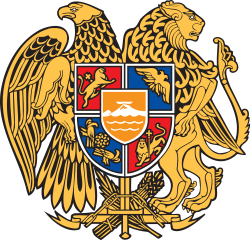Masis, Armenia
- For the nearby village called Masis, see Masis (village).
Coordinates: 40°00′50″N 44°29′09″E / 40.01389°N 44.48583°E
| Masis Մասիս | |
|---|---|
|
Masis | |
 Masis Մասիս | |
| Coordinates: 40°00′50″N 44°29′09″E / 40.01389°N 44.48583°E | |
| Country |
|
| Marz | Ararat |
| Founded | 1950 |
| Government | |
| • Mayor | Dmitri Nazaryan |
| Area | |
| • Total | 5.7 km2 (2.2 sq mi) |
| Elevation | 854 m (2,802 ft) |
| Population (2011 census) | |
| • Total | 20,215 |
| • Rank | Armenia: 15th |
| • Density | 3,500/km2 (9,200/sq mi) |
| Time zone | (UTC+4) |
| Area code(s) | +374(236) |
| Sources: Population[1] | |
Masis (Armenian: Մասիս), is a town in the Ararat Province of Armenia, located on the left bank of the Hrazdan River, 9 km southwest of Yerevan towards the Mount Ararat. The town has a large railroad commodity station that serves Yerevan, and used to connect the capital city with the Nakhichevan Autonomous Soviet Socialist Republic until the closing of the border with Azerbaijan.
Masis is one of the closest settlements to Mount Ararat and Little Ararat. The mountains are visible from most of the areas in the town.
As of the 2011 census, the population of the town is 20,215.
Etymology
Masis (Armenian: Մասիս) is the Armenian name for the peak of Mount Ararat.[2] The History of Armenia derives the name from king Amasia, the great-grandson of the Armenian patriarch Hayk, who is said to have called the mountain Masis after his own name.[2]
History
Masis is located in the Ararat plain on the left bank of Hrazdan River, 16 km southwest of Yerevan on the road to the ancient city of Artashat. It was officially formed by the Soviet government in 1950 with the merger of 3 village: Narimanlu, Zangibasar, and Ulukhanlu. Soon after it became the centre of the Masis raion. It was known as Hrazdan until 1969 when it was renamed Masis. In 1971, Masis was given the status of an urban-type settlement.
Masis has gradually developed as an industrial hub with many firms including a furniture manufacturing plant, a carpet weaving factory unit, and a paper manufacturing plant.
The town has a 16th-century chapel named after Saint Thaddeus, and a 19th-century church known as the Holy Mother of God.
Masis is connected with a number of villages stretching up to the Aras River at the border with Turkey. At nights one can see the Kurdish village lights on Mount Ararat and its mountain ridges. It has 4 seasonal weathers, with very short but hot summer and very cold winter.
Demographics
The majority of the population in Masis are ethnic Armenians who migrated from the Iranian cities of Khoy and Salmas, after the Russo-Persian War of 1826–28. They belong to the Armenian Apostolic Church. The regulating body of the church is the Araratian Pontifical Diocese, headed by Archbishop Navasard Kchoyan (seat in Yerevan).
The town's main church of Saint Thaddeus was consecrated on 4 October 2015.
Population chart of Masis since 1959:
| Year | 1959 | 1970 | 1975 | 1980 | 2001 | 2004 | 2011 |
|---|---|---|---|---|---|---|---|
| Population | 3,138 | 4,961 | 8,142 | 13,248 | 21,376 | 21,400 | 20,215 |
Economy
Masis is a major centre for tobacco products in Armenia with its two factories: the "Masis Tobacco" company and the "International Masis Tabak" company.
The town is also known for being an important centre of building materials production. It also has a heavy-duty papers factory.
Masis has many construction companies as well.
Sport
Masis FC represented the town in the domestic football competitions until 1994 when the club was dissolved due to financial difficulties.
Gallery
 Monument devoted to the victims of World War II in Masis, erected in 1983
Monument devoted to the victims of World War II in Masis, erected in 1983.jpg) Surp Gevorg Church, opened in 2009
Surp Gevorg Church, opened in 2009.jpg) Kachkar commemorating the 100th anniversary of the Armenian Genocide
Kachkar commemorating the 100th anniversary of the Armenian Genocide
References
- ↑ Ararat
- 1 2 Thomson, p. 90-98.Thomson 1978



